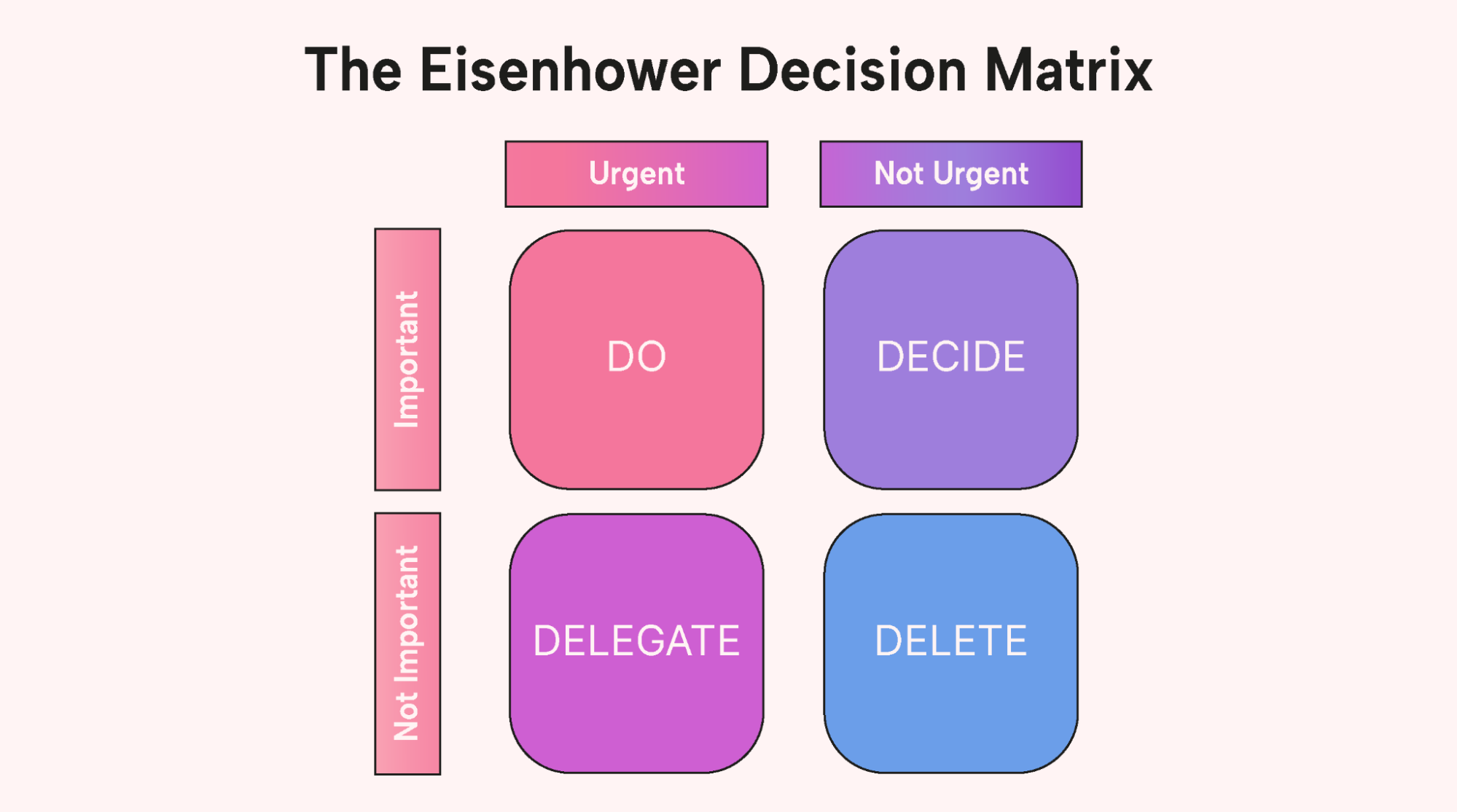How would you rate your time management skills on a scale of one to 10?
Given that we only have 24 hours per day, it’s important to make the most out of each one by prioritizing what matters most. When you prioritize, you’re less likely to waste time deciding what task to tackle next.
This is where time management techniques can be helpful. One of the most useful and user-friendly is the four-quadrant time management system. The four quadrants system helps you stay organized and focused so can you complete your workload ahead of schedule.
Does that sound like a dream come true? Then read on to learn everything you need to know about the four-quadrant time management matrix, including what this matrix is and how to use it.
What is the four-quadrant time management matrix?
The four-quadrant time management matrix is a framework for organizing tasks according to their urgency and importance.
A major challenge many people face is planning their time. For instance, we often prioritize urgent activities — including activities that aren’t very important. This consumes a lot of time that we could otherwise spend on more constructive tasks that offer long-term rewards.
The goal of the four-quadrant time management matrix is to help balance these tasks so that you prioritize the most important and urgent ones before all others.
The four-quadrant matrix was designed around the Eisenhower Matrix developed by Dwight D. Eisenhower.
The Eisenhower Matrix consists of the following four distinct quadrants:
- Do: Important and Urgent
- Decide/Schedule: Not Urgent but Important
- Delegate: Urgent but not Important
- Delete: Neither Important nor Urgent
Tasks are added to each quadrant according to their priority.
Covey’s Time Management Matrix is similar, consisting of the following quadrants:
- Quadrant I: Important and Urgent
- Quadrant II: Not Urgent but Important
- Quadrant III: Urgent but not Important
- Quadrant IV: Neither Important nor Urgent
Understanding the 4 quadrants of time management
The best way to understand the four-quadrant time management matrix is by defining each quadrant.
 |
Do
The first quadrant in the time management matrix covers tasks considered both urgent and important — in other words, critical tasks.
These are the work tasks that have a deadline looming, and if you don’t address them in a timely manner, you might face consequences. For example, if you have a project due for a new client on Friday and you don’t complete it until the following Tuesday — which is way past the deadline — that new client may move on to your competitor instead of hiring you for other projects.
Some “Do” tasks are extremely time-sensitive, forcing you to shift around other priorities to make them happen. Suppose you run a small event-organizing agency and receive an offer to set up a 30-person-capacity venue within a few hours. Unless you have even more pressing tasks, you might instruct all employees to put whatever they are doing on hold and focus on executing this task.
Decide or schedule
The second quadrant consists of tasks that might be just as important as those in the first one but aren’t urgent.
Activities in this quadrant often require extensive planning — including multiple approvals and meetings — before their execution.
Other tasks may fall into this quadrant because they require capacity-building. In this case, the business keeps the task pending as they wait to reach full capacity.
Suppose your business has been contracted to provide large-print posters but doesn’t have the required printing machine. This means you must lease or procure a new printer to deliver on client expectations. However, you’d be ill-advised to wait until the printer arrives to start the work. Instead, your business may begin planning for the task by procuring other necessary resources, like printing paper and ink.
Delegate
This quadrant consists of tasks that require urgent attention but aren’t important. They typically can’t be completely ignored because they help ensure the organization’s systems run smoothly.
Typical tasks in this quadrant include answering calls and emails.
Team members with senior roles, like managers and team leaders, can delegate these low-value tasks so they can focus on more important ones.
Delete
Tasks in this quadrant are neither urgent nor important. As such, they can be removed completely to allow you to clean up your to-do list.
Suppose you have a tight schedule consisting of school exams, work, and family commitments. You can reduce the time you spend on social media and allocate these extra hours to more important tasks. Alternatively, you could choose to stop spending any of your time on social media.
Benefits of effective time management
Everyone stands to benefit from effective time management. Here are some benefits:
 |
You prioritize the most important and urgent tasks
Effective time management means prioritizing the most important and urgent tasks over all others. It makes sure you allocate time to tasks that have the greatest benefits when completed or the severest consequences when not. For example, a certification exam that would position you for a job promotion is something that you shouldn’t miss.
Other tasks or events may be important and urgent because they only happen once. An example would be a child’s preschool graduation.
You free up resources
Effective time management reduces resource wastage. You can use the four-quadrant time management matrix to identify tasks that are neither urgent nor important. Then, reduce the time allocated to these time-wasting activities or remove them permanently. This will likely free up time and resources to focus on more important things.
You avoid task duplication
Task duplication can result in a tight schedule.
Suppose your weekend to-do list indicates that you need to shop for groceries and toiletries. Opting to schedule these activities on different days would be a waste of time unless you have specific reasons for doing so. On the other hand, completing both tasks at the same time — by shopping in an all-in-one store, for instance — is an effective time management tactic.
You create a comprehensive schedule
Effective time management emphasizes creating a comprehensive schedule to boost your personal productivity. This schedule should account for various activities, including complex tasks, critical tasks, and everyday tasks. You may also want to include low-priority tasks that don’t need urgent attention.
 |
Creating a comprehensive schedule lets you track the amount of time you spend on various tasks. You can then adjust your schedule to ensure that you’re spending the most amount of your time on major tasks, improving your productivity as a result.
5 steps for assigning tasks to the time management matrix
The four-quadrant time management matrix is only effective if you assign your tasks appropriately. Placing a task in Quadrant 4 when it should be in Quadrant 3, for instance, may throw a wrench into your schedule.
Here are five simple steps to help you prepare an effective time management matrix:
1. Identify all relevant tasks
The first step in creating an effective time management strategy is preparing your list of tasks. Include all tasks, regardless of their complexity, urgency, or importance, and be sure to add activities from both your professional and personal life.
Pro tip: consider splitting particularly large or complex tasks into more manageable chunks.
2. Determine each task’s deadline
Establish a deadline for each task to provide a basis for determining the tasks’ urgency. The deadlines should be accurate, as they will influence the priority matrix.
For example, indicating that an exam is due in three months and not three weeks means you might prioritize more time-sensitive goals.
3. Rank the tasks based on their urgency
A common mistake when ranking tasks based on urgency is failing to account for the time needed to complete them. So, rank the tasks with the shortest deadlines first but also consider how long you’ll need.
Suppose you have two essays to write — a 300-word one and a 10,000-word one — and both are due on the same day. If you’re like most people, you would likely need at least a week to complete the longer piece. This would make it more urgent than the 300-word assignment, even with the same deadline.
4. Rank the tasks based on their importance
Distinguish between your important and unimportant tasks to ensure you allow for ample time to complete the former.
For example, preparing for a final exam would likely be more important than finishing a novel in time for your next book club meeting.
5. Place the tasks in the quadrants
This step relies on how you ranked your tasks in Step 3 and Step 4 above. Place the tasks in the quadrants they correspond with, depending on their urgency and importance.
Make time for the work that matters using the four quadrants
Working more hours doesn’t translate to more productivity. The best way to get the most out of your day is to use a practical, purposeful schedule.
Effective time management will help you complete the items on your to-do list — and still have some extra hours to rest or have fun.
Here’s some even better news: you can use a time management tool like Motion to organize your schedule for you.
Motion has a calendar manager that you can use to schedule all pending tasks. You can set the app to send you an alert a few days before a task’s due date.
Motion can also reorganize your schedule when you introduce new tasks to help you stay on top of your schedule.
Achieve more in less time with Motion. Sign up for a 7-day free trial today.





